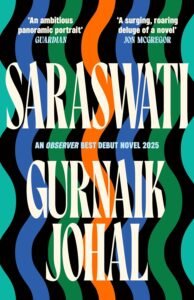
In publishing it has been a year for highlighting the importance of rivers and water, from Robert Macfarlane’s Is a River Alive? to the release of the paperback edition of Elif Shafak’s There Are Rivers in the Sky. Joining these works in a triumvirate is Saraswati, the debut novel from award-winning short story writer, Gurnaik Johal. Published by Serpents Tail this Summer, Saraswati, was one of several debuts earmarked by the Observer at the start of the year, as well as most recently being shortlisted for the Waterstone’s Prize for Debut Fiction. Johal has produced an ambitious and expansive work themed around the politicisation of a river; the re-emerging Saraswati in India.
‘Saraswati is best known as part of the Tridevi: Saraswati goddess of language, knowledge, speech, art, music; Lakshmi, goddess of wealth, fertility, earthly and material fulfilment; Parvati, goddess of power beauty, love and spiritual fulfilment.
Mind, body, soul.’
As explained early in the novel, Saraswati combines both theological and geographical inspiration. Saraswati, a Hindu female goddess, is forced to hide from Brahma on Earth as a river and then later bury herself deeper from his gaze, underground. This disappearance parallels the ancient Saraswati river mentioned in the Vedas, which is believed to have run dry as a result of tectonic changes leading to the loss of the Harappan civilisation it supported.
In Gurnaik Johal’s Saraswati – this novel of myth, place and politics – a great deal of research has gone into exploring many contemporary themes. Stemming from the return of water due to glacial melt, the Indian government leverages this new amenity: using a river as a political tool to launch a new and dangerous patriotism. Saraswati, and the language of ancient Bharat (the other name for India), propels Indians away from memories of colonial pasts and towards not just cultural reclamation but the promise of additional successes: riches, space programs, and expansion and growth at the expense of border nations. The neighbours rely on a water supply, which is modulated through artificial governmental control of the new Saraswati. These notions parallel the Indus water treaty, first established in 1960, and focussed on the sharing of water from the Indus, Chelum and Jenab which flow between India and Pakistan. In recent years, and in particular earlier in 2025, friction between the two neighbours came to a head with India threatening to dry out Pakistan; rivers and waters are being used as political weapons.
For Johal’s story of Saraswati, he continues the river theme, telling parallel tales of relatives from a common ancestor; tributaries from a single source. Johal uses his skill as a short story writer (see We Move (Serpent’s Tail; 2022)) to create an ensemble cast who show us a path back to India amidst the rise of the Saraswati river. The seven stories stem from seven siblings, many of whom left India in the early 19th Century, and reflects the lives of diaspora worldwide. We travel between a range of locations, including the Chagos Islands, Canada and Kenya before an eventual pull back to India. Chapters are arranged sequentially, turning to each character in turn but interspersed with the linking story of their ancestral origin. In this way, there is a short story feel to Saraswati; individual viewpoints which convolve at the end, at the river’s mouth – to continue the metaphor. With more limited time spent on each character, Johal focusses on plot, contemporary geopolitics and the environment for engagement, propelling you through each character’s section. All parts of Saraswati are rich with culture from the Indian subcontinent and for me, particularly with not having access or being very familiar, this was an engrossing and enriching learning experience. Being greedy for more education, a map of the rivers and the character locations may have also been a useful aid in remembering where we are at any particular time. This is of course an ‘optional extra’ and I like the way Johal isn’t overly hand holdy. He allows his readership to apply as much or as little effort as they select for their own requirements in enjoyment and immersion.
In addition to politics, Saraswati, covers environmental activism, the role of the fourth power/estate (journalism/media) and belonging. To where and to what do you belong as a diaspora; it can of course be to both countries of heritage and situation.
‘Still water isn’t safe,’ he said, ‘it’s supposed to flow. We’re supposed to move.’
Seeing Johal speak at Blackwell’s Manchester at the start of June, his book appeared both foreboding and prescient given April’s reignition of hostilities between Pakistan and India on the backdrop of environmental destabilisation. This is naturally the power of imaginative literature; Johal has not had to stray too far from current events in the generation of this story to pose questions to his readers: are we doing enough for the environment? Do governments have an individual’s best interests at heart? What is the price of rampant patriotism? It seems that very commonly now, political leaders are trying to render the past into the present, as though cultural nostalgia is the perfect currency for votes and time in office.
‘It had been an early education, Nathu thought, in the fact that all history was historical fiction. A story had a longer life than a fact.’
I enjoyed this book immensely, it is both politically charged and culturally rich. I like the way Johal’s brain works and he has applied serious effort in covering a vast range of contemporary themes. I think he could easily split out any of these stories into full novels; there’s much to get interested in. Post reading, as these ideas have further settled, there’s been the additional slow burn, second wave of enjoyment as all the information sinks in. I think this is often a great measure of quality in stories – how well they stay with you and what they will prompt you to learn next.
D